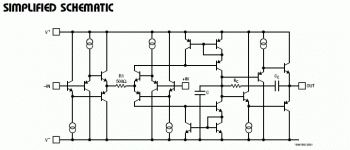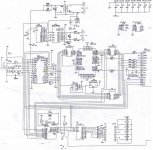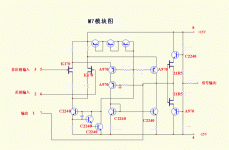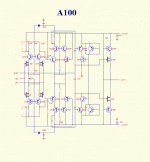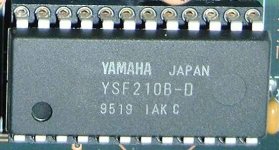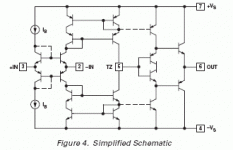peufeu said:Yes, AD825 has some problems, it sounded the same as you say for me...
Because the IV is a very critical position. On each sample transition, the DAC basically outputs a step between the old and the new sample with a very fast slew rate and settling time.
Old crud like NE5532 is certain to go into slew limiting, then, and fast opamps will sound better.
In the end I used a folded cascode...
peufeu, so you too use the AD825 or something else more exotic?, please give your preferences as I need direction, I tried to look at you web site, but it goes crazy on me.
Cheers George
Have a look at this. A little extreme in its power requirements especially in differential form and even more so if you try to dc-couple it but it may be what you are after.
Something else might want enquire about. The figures for the internal 8x oversampling filter in the PCM1738E are less than stellar. Something like the PMD100 is vastly superior. Fortunately the internal 8x filter can be bypassed allowing for the use of an external oversampling filter.
Something else might want enquire about. The figures for the internal 8x oversampling filter in the PCM1738E are less than stellar. Something like the PMD100 is vastly superior. Fortunately the internal 8x filter can be bypassed allowing for the use of an external oversampling filter.
I just remembered I have a couple of these LT1364 blindingly fast ones that I bought a while back, what do you guys think for the I/V stage? Below is the simplified circuit diagram.
I remember I put them in the output stage of an MSB Link Dac once for a customer and they ocsillated like mad, so we went for some OP275 's instead, and he gave them to me, cost him $60au each.
http://www.linear.com/pc/productDetail.jsp?navId=H0,C1,C1154,C1009,C1022,P1106
Cheers George
I remember I put them in the output stage of an MSB Link Dac once for a customer and they ocsillated like mad, so we went for some OP275 's instead, and he gave them to me, cost him $60au each.
http://www.linear.com/pc/productDetail.jsp?navId=H0,C1,C1154,C1009,C1022,P1106
Cheers George
Attachments
rfbrw said:Something else might want enquire about. The figures for the internal 8x oversampling filter in the PCM1738E are less than stellar. Something like the PMD100 is vastly superior. Fortunately the internal 8x filter can be bypassed allowing for the use of an external oversampling filter.
I believe it does, the CS8420CS doesn't it?
Cheers George
Attachments
peufeu, so you too use the AD825 or something else more exotic?, please give your preferences as I need direction, I tried to look at you web site, but it goes crazy on me.
I used it, but didn't really like the sound. Currently I use this quite famous circuit :
An externally hosted image should be here but it was not working when we last tested it.
It gives the DAC a low impedance (an emitter). After the second transistor you add a RC filter, maybe even 2nd order, and then the signal edges are smoothed enough to widen your choice of opamp (or not to make the imput stage of your preamp slew limit).
georgehifi said:
I believe it does, the CS8420CS doesn't it?
Cheers George
No it doesn't. The 8420 acts as the SPDIF rx as well as converting all to 96K and the SM5849 performs an additional 2x conversion to 192K when selected. The PCM1738E's onboard 8x filter is still very much in circuit.
rfbrw said:Something else might want enquire about. The figures for the internal 8x oversampling filter in the PCM1738E are less than stellar. Something like the PMD100 is vastly superior. Fortunately the internal 8x filter can be bypassed allowing for the use of an external oversampling filter.
Why is PMD100 better then the 8X incorporated dig. filter, other filter type?
I am thinking of an upsampling 24bit dac with PCM1798 and SRC4192
The datasheet sometimes tells you how much bits of precision are used in the DSP parts, and in the storage of the FIR coefficients, and how much coefficients, and how the dither is done, but all that stuff is a compromise between silicon area (=price) and quality...
If it were not for that, everyone would be using 64-bit floating point arithmetic.
Sometimes you get really über cr*p like the old soundblasters which converted sample rate using 16 bit arithmetic, which pretty much ate a big chunk of LSBs.
If it were not for that, everyone would be using 64-bit floating point arithmetic.
Sometimes you get really über cr*p like the old soundblasters which converted sample rate using 16 bit arithmetic, which pretty much ate a big chunk of LSBs.
tubee said:
Why is PMD100 better then the 8X incorporated dig. filter, other filter type?
I know such things are infra dig around here but the numbers tell the story. And the numbers for the PMD100 are way ahead of those for the internal 8x filter of the PCM1738E.
I am thinking of an upsampling 24bit dac with PCM1798 and SRC4192
ASRC's are for bridging clock domains and that they also suppress jitter is a nice bonus. If I want to raise the sample rate I will use a device expressly designed for that task.
rfbrw said:ASRC's are for bridging clock domains and that they also suppress jitter is a nice bonus. If I want to raise the sample rate I will use a device expressly designed for that task.
The jitter supress is where i'm after indeed. Also a better resolution from CD: 16 bit without and some more with 4X OS (saa7220) it can be a lot better i guess.
PMD is a lot more expensive then the SCR, and not easy to find either.
The SRC is designed for that task, but what do you recommend Rfbrw? (Think of I2S from a CDM -> SCR -> 24 bit dac. Also a USB-I2S is in pipeline.)
With the help of Ruach I found some cheap Chinese made discrete ready made opamps, for my I/V stage what do you guys think of them. Especially if someone can read Chinese.
http://www.audio-gd.com/PRO/diy/MD/MD.htm
http://www.audio-gd.com/PRO/diy/MD/MD.htm
Attachments
PMD100 is expensive for two reasons :
- the digital processing is of good quality
This means more silicon area, hence more expensive. For instance when you do FIR filtering, you can store the results in a 24 bit register or a 32 bit register. More bits is more expensive, but after your computation is finished, gives less roundoff errors.
- it pays HDCD royalties
- the digital processing is of good quality
This means more silicon area, hence more expensive. For instance when you do FIR filtering, you can store the results in a 24 bit register or a 32 bit register. More bits is more expensive, but after your computation is finished, gives less roundoff errors.
- it pays HDCD royalties
georgehifi said:With the help of Ruach I found some cheap Chinese made discrete ready made opamps, for my I/V stage what do you guys think of them. Especially if someone can read Chinese.
http://www.audio-gd.com/PRO/diy/MD/MD.htm
georgehifi said:And this one.
Cheers George
They look like the kind of thing you'll find in a 20 year old back issue of the Japanese magazine MJ.
peufeu said:
- it pays HDCD royalties
The PMD100 was made by Pacific Microsonics. Why would they pay royalties to themselves?
It is expensive because it is no longer made, has a good reputation and is in demand. Good old fashioned supply and demand.
tubee said:
The jitter supress is where i'm after indeed. Also a better resolution from CD: 16 bit without and some more with 4X OS (saa7220) it can be a lot better i guess.
PMD is a lot more expensive then the SCR, and not easy to find either.
The SRC is designed for that task, but what do you recommend Rfbrw? (Think of I2S from a CDM -> SCR -> 24 bit dac. Also a USB-I2S is in pipeline.)
If jitter is your bogeyman, hiding under the bed and stalking you at every turn then the SRC4192 will sort it.
Seriously, go with what you feel will work for you. I see it as a trade off. Many feel what is gained by using a device like the SRC4192 outweighs any possible disadvantage. I, otoh, am somewhat dubious about the magnitude of the problem in the first place.
peufeu said:it pays HDCD royalties
I have only one HDCD disc, Supertramp, cheap offer. I'm not after HDCD
rfbrw said:
If jitter is your bogeyman, hiding under the bed and stalking you at every turn then the SRC4192 will sort it.
Seriously, go with what you feel will work for you. I see it as a trade off. Many feel what is gained by using a device like the SRC4192 outweighs any possible disadvantage. I, otoh, am somewhat dubious about the magnitude of the problem in the first place.
It is logic to me a resampled signal has less jitter: it is a sort of reclocked. And when SRC done with good peripheral (gnd scheme, PS, and pcb layout) could give nice results. Agreed sometimes is jitter only a small problem compared to other problems, nowadays in chip design the price more important then quality, the mp3 listeners won't hear it anyway. There are only a few people who want good quality, so thats not their aiming point.
peufeu, what do you think of this one, it' got the low impedance input like yours?
Found a new one that AD built taking strong design for I/V conversion into account , note the input low impedance emiter loading, 2000vus slew rate and fast settling and 60mhz bandwidth. How does the schematic of this look for I/V?
http://www.analog.com/UploadedFiles/Data_Sheets/AD844.pdf
Cheers George
Found a new one that AD built taking strong design for I/V conversion into account , note the input low impedance emiter loading, 2000vus slew rate and fast settling and 60mhz bandwidth. How does the schematic of this look for I/V?
http://www.analog.com/UploadedFiles/Data_Sheets/AD844.pdf
Cheers George
Attachments
I'm gonna sound like obi-wan :
I've never tried current feedback opamps for IV. Although on paper they are ideal, some people like the sound and some hate it.
I've never tried current feedback opamps for IV. Although on paper they are ideal, some people like the sound and some hate it.
- Status
- Not open for further replies.
- Home
- Source & Line
- Digital Source
- Need advice from all I/V Aficionados using the THS4031's
